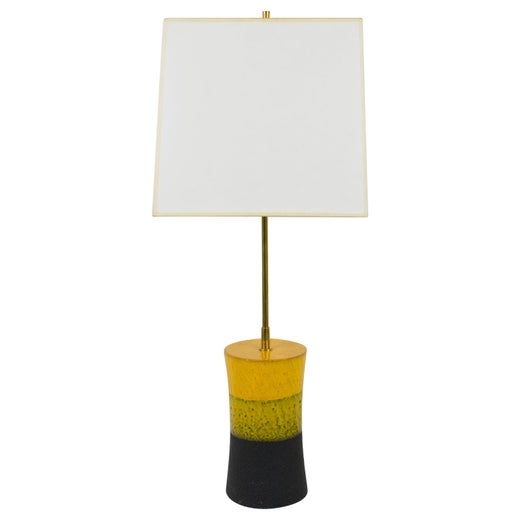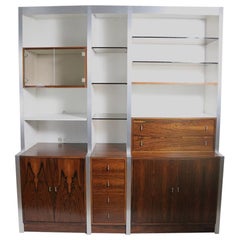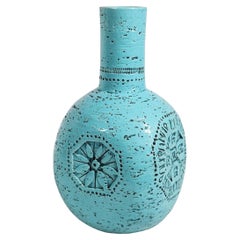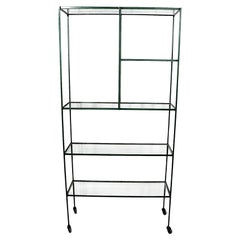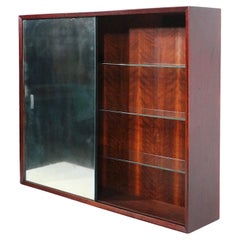Cado Wall Unit Imported by Raymor
About the Item
- Creator:Raymor (Retailer)
- Attributed to:Poul Cadovius (Designer)
- Dimensions:Height: 72.5 in (184.15 cm)Width: 140 in (355.6 cm)Depth: 17 in (43.18 cm)
- Style:Scandinavian Modern (Of the Period)
- Materials and Techniques:
- Place of Origin:
- Period:
- Date of Manufacture:1950s-1960s
- Condition:Wear consistent with age and use. Cosmetic wear as described in listing.
- Seller Location:New York, NY
- Reference Number:1stDibs: LU97878046513
Raymor
Few had their finger on the pulse of American furniture like importer and distributor Raymor. Founder Irving Richards first had his eyes opened to the world of furniture while attending the 1928 Salon d’Automne art and design fair in Paris. He joined Lightolier two years later and developed its business relationships, including with designer Russel Wright.
Wright and Richards met in 1935 and Russel Wright, Inc. was formed in 1936. Its American Modern ceramic tableware, produced under the name Wright Accessories in 1938, was a notably lucrative collaboration. Following the early success of American Modern, Richards obtained the majority share of Wright Accessories and changed its name to Raymor Mfg Division Inc. in 1941.
By 1952, the exclusivity over American Modern had ended (the line was initially produced by Wright Associates and later manufactured by Steubenville for two decades). To keep up with American markets, Raymor worked with prominent designers such as George Nelson, Arthur Umanoff, Ray and Charles Eames, and Hans J. Wegner.
The company’s imports expanded to Denmark, which contributed to the rise of Scandinavian modern designs in the American market. Throughout the 1950s, Richards established relationships with factories in Scandinavia, Italy and Germany, as well as with the influential tastemaker and importer Charles Stendig.
The furniture company Simmons bought Raymor in 1963 and changed its name to Raymor Richards, Morgenthau Inc. in 1969. During that time, Raymor’s Omnibus range of Scandinavian-style wall units became widely popular, along with Italian glass and pottery like Bitossi ceramics designed by Aldo Londi and Bagni ceramics by Alvino Bagni.
Shifting styles coupled with rising competition, and the departure of Richards from the company, ended Raymor. By the late 1970s, Raymor faced a wave of international factories able to produce similar products of lesser quality for a lower cost. Buyers were eager to frequently change their interior styles, limiting the need for high-end, durable furniture, which Raymor had been importing.
On 1stDibs, find a collection of vintage Raymor ceramics, lamps, decorative objects and more.
You May Also Like
Vintage 1950s Danish Scandinavian Modern Shelves and Wall Cabinets
Teak
Vintage 1950s Danish Mid-Century Modern Shelves and Wall Cabinets
Rosewood
Vintage 1950s Danish Scandinavian Modern Shelves and Wall Cabinets
Rosewood
Vintage 1960s Danish Scandinavian Modern Shelves and Wall Cabinets
Teak
Vintage 1960s Scandinavian Mid-Century Modern Shelves and Wall Cabinets
Teak
Mid-20th Century Mid-Century Modern Shelves and Wall Cabinets
Teak
Vintage 1970s American Mid-Century Modern Shelves
Aluminum
Vintage 1960s Dutch Mid-Century Modern Shelves
Metal
Vintage 1960s Scandinavian Modern Shelves and Wall Cabinets
Walnut
Late 20th Century American Mid-Century Modern Shelves and Wall Cabinets
Metal
More From This Seller
View AllMid-20th Century American Mid-Century Modern Shelves and Wall Cabinets
Metal
Mid-20th Century Italian Mid-Century Modern Vases
Ceramic, Pottery
Mid-20th Century American Mid-Century Modern Shelves
Iron
Mid-20th Century Danish Scandinavian Modern Shelves and Wall Cabinets
Mirror, Walnut
Antique 19th Century French Victorian Wall Brackets
Giltwood
Mid-20th Century American Hollywood Regency Shelves and Wall Cabinets
Glass, Giltwood
